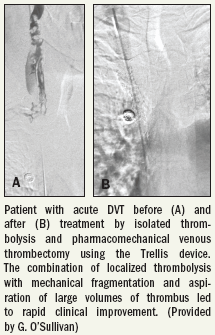Interventional approach offers fast deep vein thrombosis relief
There is a growing consensus that interventional radiologists should take over the management of deep vein thrombosis (DVT) to resolve the continued undertreatment of patients.
There is a growing consensus that interventional radiologists should take over the management of deep vein thrombosis (DVT) to resolve the continued undertreatment of patients.
Patients presenting with signs of DVT will often be prescribed anticoagulant drugs to prevent the thrombus from growing and to stop new clots forming. But this is not always enough to stop the development of long-term symptoms, such as calf pain, rashes, and swelling. The problem is that the physicians who initially see these patients do not realize the poor outcomes of their approach to DVT, said Dr. Gerry O'Sullivan, an interventional radiologist at Galway University College Hospital in Ireland.
"As far as they are concerned, once they have treated the patient, given anticoagulants, that's it. But the patients then come back to me or a vascular surgeon with venous post-thrombotic syndrome, and that is a big problem," he said. "Interventional radiology should take over DVT. We can diagnose it, we can treat it, and follow-up is straight-forward."

Systemic thrombolysis can be used to dissolve venous clots, but this strategy is linked to a high rate of bleeding problems. One alternative is to use catheter-directed thrombolysis (CDT), in which a clot-busting drug such as tissue plasminogen activator (tPA) is dripped directly into the target vein over two or three days. Another option is pharmacomechanical thrombectomy (PMT), in which the clot is destroyed by a combination of physical force and targeted thrombolysis.
Approximately 13 patients have been treated with CDT and 70 with PMT at Galway University College Hospital. All PMT procedures are performed with a Trellis device (Bacchus Vascular), which uses a rapidly rotating wire to break up venous blood clots. The blended mixture of broken thrombus and thrombolytic agent is then sucked out. The whole procedure can be completed in less than two hours, or 30 minutes per segment.
Although both CDT and PMT are good procedures, the pharmacomechanical option has certain advantages, O'Sullivan said. The procedure is quicker, less time is spent with patients in the intensive care unit, and less tPA is needed. There is also little chance of the thrombolytic agent or parts of the broken clot "escaping" into the circulation.
"We have treated patients with hemorrhagic brain metastases; we have treated patients with active gastrointestinal bleeding. They have not bled, and they have not had a stroke," he told delegates at ECR 2009.
The extent of the DVT also influences which method is used. If the whole limb is involved, or when a case is acute-on-chronic DVT, then CDT is preferred, O'Sullivan said.
Study Shows No Impact of Hormone Therapy on PET/CT with 18F-Piflufolastat in PCa Imaging
May 7th 2025For patients with recurrent or metastatic prostate cancer, new research findings showed no significant difference in the sensitivity of 18F-piflufolastat PET/CT between patients on concurrent hormone therapy and those without hormone therapy.